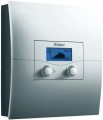Automatic temperature control hysteresis provided by the device.
Hysteresis can be described as the difference between the on and off temperatures of a system controlled by a thermostat. Usually, the permissible deviations of the actual temperature from the nominal one in one direction or another are half the hysteresis. So, at a set temperature of 22 °C and a
hysteresis of 0.5 °C, the controller will turn on the heating as soon as the room temperature drops to 21.75 °C, and turn it off when it rises to 22.25 °C. Accordingly, the lower this indicator, the more carefully the temperature is maintained and the fewer fluctuations. On the other hand, small hysteresis values require accurate and expensive thermal sensors, increase fuel/energy consumption and wear of the entire system, and create an increased risk of false alarms (for example, from a cool draft on the thermal sensor). In addition, relatively small temperature fluctuations are practically imperceptible in terms of human comfort. Therefore, many modern thermostats have a
hysteresis of 1 °C — this, usually, is quite enough for domestic use.
Also note that this parameter can be both
fixed and
adjustable. The first option is simpler and cheaper, and the second provides additional options for setting the thermostat to the specifics of the situation.
The largest number of individual cycles that the thermostat timer can set in one day.
The cycle is the period during which the thermostat operates on one set of settings. For example, if there are 2 cycles, you can provide turning off the heating while you are at work and turn it on shortly before returning home. However, most thermostats provide a noticeably larger number of cycles — up to 24.
Note that in weekly timers (see "Timer type") this parameter may differ depending on the day of the week. For example, weekdays usually have more extensive settings than weekends.

